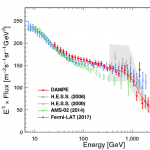Paper of the month: DAMPE: a spectral break and a new excess in the TeV spectrum of cosmic-ray electrons and positrons

High-energy cosmic rays, i.e., particles traversing the space at energies which are much larger than their rest masses, provide a probe of galactic high-energy processes. They may shed light on the nature of such intriguing phenomenon as Dark Matter (DM) by maybe enabling observation of DM annihilation or decay.
December 19, 2017 by tiinatimonen
The Dark Matter Particle Explorer (DAMPE) is a satellite equipped with a particle detector optimised for studies of high energy cosmic-ray electrons and positrons (CREs), ions and γ-rays. Its main scientific objective is the search for DM. It has unprecedentedly high energy resolution for CRE measurements and can detect CREs and γ-rays possessing energies up to 10 TeV.1
In Ref. [1], the DAMPE Collaboration has presented the results of a direct measurement of CREs. Figure 1 shows the CRE spectrum measured by DAMPE, compared with previous results from the space-borne experiments AMS-02 and Fermi-LAT, as well as the groundbased experiment of the H.E.S.S. Collaboration.
The data in the energy range from 55 GeV to 2.63 TeV fit much better to a smoothly broken power-law model than to a single power-law model (see Ref. [1] for details). A spectral break occurs at E ≈ 0.9 TeV, which confirms the previous evidence found by the H.E.S.S. Collaboration. This observed spectral softening, as well as the peak at 1.4 TeV, require an explanation. We note, however, that the peak occurs in a single bin, and it need to be confirmed or rejected in the future when more precise data become available.
The spectral softening points to a cut-off of the background electron spectrum, which could imply that electrons can only be accelerated up to some maximum energy in the sources. Another possibility to explain the flux is that the charged particles are coming from DM decay or annihilation. It turns out, however, that in simplified models, final states which can lead to the observed DAMPE flux produce too many photons which exceed experimental limits. A different explanation of the observed flux and the positron fraction is pulsars, which fit well with the data.
The peak in the DAMPE data could be possibly explained by cold ultra-relativistic e+e− from a pulsar close to the Earth. Another possible explanation for the peak is DM annihilation. The annihilation cross section of DM needed to explain the DAMPE peak requires a local density which is more than ten times larger than the local DM density obtained from cosmological N-body simulations of structure formation. This makes the probability of having such a DM clump rather small, unless the cross section is enhanced by some mechanism.
DAMPE is designed to operate for at least one more year, and it will probably be extended to a longer period. Additional data will allow more precise measurements of the high energy CRE spectrum. This will improve our understanding of cosmic-ray electrons and positrons and hopefully shed light on the nature of DM.

Figure 1: The CRE spectrum (multiplied by E3) measured by DAMPE. The red dashed line represents the best fit broken power law to DAMPE data in the range from 55 GeV to 2.63 TeV. The figure is taken from Ref. [1].
Text by Julia Gehrlein and Arsenii Titov
1The energy of 1 TeV is approximately two million times greater than the rest mass of the electron
References
[1] G. Ambrosi et al. [DAMPE Collaboration], Nature 552 (2017) 63 [arXiv: 1711.10981 [astro-ph.HE]].


